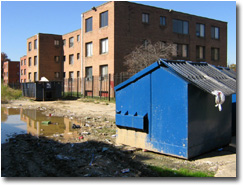
Project Funder: U.S. Department of Housing and Urban Development (HUD)
Project Partners: Wheeler Terrace Tenant Association,
Wiencek + Associates Architects + Planners, and
Community Preservation Development Corporation (CPDC)
Project Contact: David Jacobs,
djacobs@nchh.org
What we studied: The effect of conducting building renovations that meet green housing standards on indoor air quality and resident health in multifamily housing.
What we found: Residents living in dwellings renovated to green standards reported significant reductions in dampness problems, pests, and pesticide use after work. Mouse and cockroach allergen levels were significantly lower than before work for at least one year after renovation. The percentage of residents reporting their general health was good or better significantly increased from before to one-year after renovation.
Why it matters: Pests and dampness/mold are two documented triggers of respiratory illness exacerbation. Incorporating Enterprise Green Communities and LEED standards in low-income housing renovation improves housing conditions and resident health. Communities should require or incentivize developers to follow green housing standards that include health-related requirements.
Project Description: The National Center for Healthy Housing (NCHH) studied how incorporating green building design into low-income housing rehabilitation could promote health and reduce environmental exposures. In 2006, the District of Columbia adopted one of the farthest-reaching green building laws in the nation; as a result, the rehabilitation of Wheeler Terrace Apartments in the Ward 8 Anacostia section of DC commanded local and national attention because it was one of the first projects to meet the provisions of the law.
Healthy homes interventions in the Wheeler Terrace rehabilitation project included ventilation system modifications to improve fresh air supply and distribution, installation of bathroom and kitchen exhaust fans, improved building envelope sealing to control moisture and pest intrusion, and integrated pest management (IPM) programs. Training of construction and developer staff and education of community residents helped to ensure that healthy homes principles continued after this demonstration project was complete.
Of the 102 occupied housing units available, NCHH enrolled 44 households containing 57 adults and 64 children. Twenty-five (25) households containing 27 adults and 31 children completed the follow-up approximately one year after the rehabilitation. NCHH visually assessed dwelling condition and interviewed residents about their health and comfort before and one-year after rehabilitation. Dust allergen samples (cockroach, mouse, rat, and dust mite) were collected from a subset of housing units.
The percentage of adults reporting their health as good or better improved from 59% (pre-work) to 67% (one-year after work) (p = .026). Residents also reported statistically significant reductions in water/dampness problems, cockroaches and rodents, and pesticide use. Median cockroach (Bla g1) and mouse (Mus m1) allergen dust loadings showed large and statistically significant reductions from baseline to three months post-intervention that were sustained at one year (both p < .05). Energy and water cost savings were 16% and 54%, respectively.